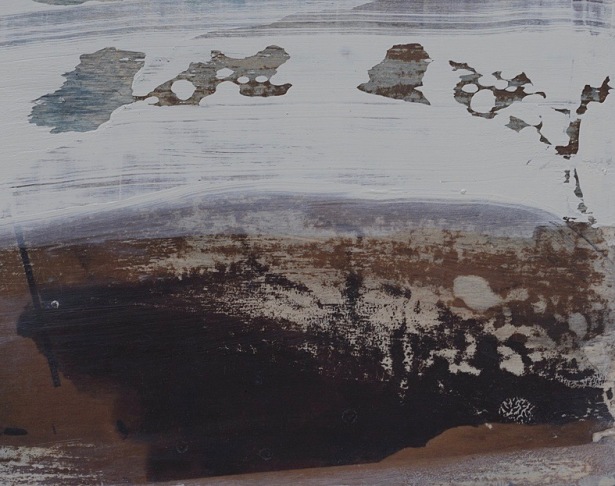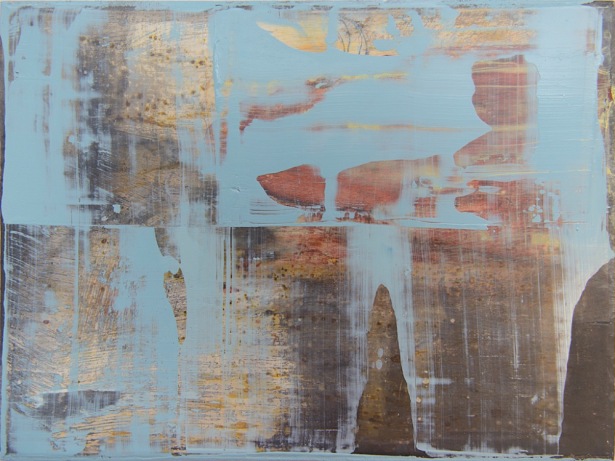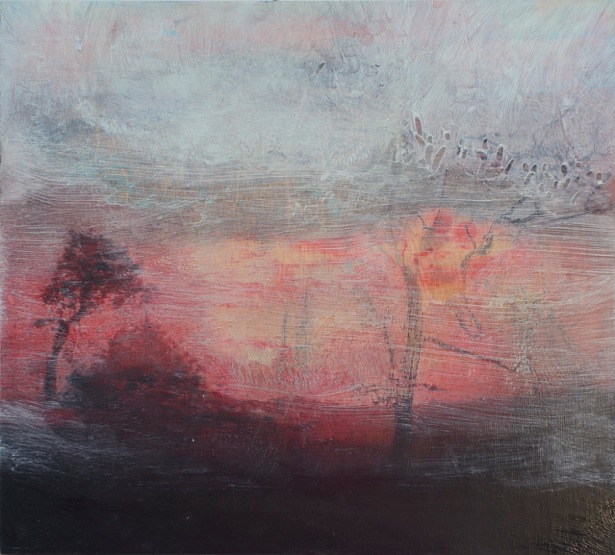This post comes from the Artists and Climate Change Blog
If you look through critical writing about Siobhan McDonald’s artwork you would not be immediately aware that she is pre-eminently a painter. But it is with the sensibility of a painter that she views the issues of our time. On the day on which I first met her, at her studio in the Science Faculty at University College Dublin, it had just been announced that Cheddar Man, the oldest known human inhabitant of the British Isles and ancestor of the British (and Irish) people was not white, as previously thought, but black. New DNA evidence revealed that the ethnic purity of the white ‘master’ race was based on nothing more than a false, and generally, harmful assumption. Science has a way of reviewing even the most cherished beliefs, and confronting us with alternative hypotheses to what we think is the truth. As an artist, Siobhan McDonald has devoted herself to bringing visibility and sense to subtle, even invisible shifts in knowledge.

Siobhan McDonald – art pieces and source material
Like the great painters of the past, she is interested in the mystery of existence, “what is still unknown to science, exploring the origins of life and plants as a way to see clearly into the future.†Her field of vision is large. It extends across time and space in search of artistic vehicles that can carry the wonder, the mind-numbing terror of change over temporal and spatial spans that we cannot begin to imagine. She invites us to consider how past and future might come together, keeping a forensic as well as an aesthetic eye on the traces and residues of past activity and the scientific studies that suggest future direction, bringing her closer to an understanding of the phenomena that feed her art project. She moves between examination of the evidence of biological and historical activity hidden in the icy landscapes of the Arctic Circle, to volcanic activity in the same region, creating her own seismometer to record tectonic shifts in the earth’s substrata, making artwork to reflect the fossilization of an object as modern as an abandoned Dakota DC3 aircraft, bringing a painter’s eye to bear on the accretions painted by time on to its surface. This merely parallels her own painting process. “Paint congealed and reacting to time for me suggests possibilities… a form of alchemy that transforms our understandingâ€.
Her philosophical landscape is filled with evidence of the strength and continuity of natural forces. While there is something biblical about the power and might of geological change, McDonald is just as quick to spot and be moved by quieter, but no less inexorable temporal alteration. Thus, Silent Witnessing (2017), is simply composed of a sheet of paper, which once formed the backing to a collection of rare butterflies in UCD. The butterflies had long since turned to dust, and been swept away to prepare for other research species. Only McDonald was sensitive to the potent image left in their wake by dust and melanin, describing their patterned imprint as “a natural photogram.â€
In pursuit of her goals she has embraced sculptural installation, photography, sound, video, found objects and chance occurrences, even materials so new, they are only being invented as she uses them. Her paintings, as the short documentary video Chrystalline: Disappearing Worlds reveals, are informed by all of them. What does it mean to take a pre-existing image, literally frozen in time as the plate glass photographs of failed, nineteenth century Arctic expeditions were, and to re-imagine them in paint? The act of painting becomes a means to feel your way into the experience of the original photographers, to consider what they saw, to add the dimension of present time and your own thoughts as you examine each mark, scratch and erasure in the original. The paintings are influenced by the ravages of a century of concealment in ice on those glass plates; their tracery becomes part of her painterly alphabet. The battered figures in paintings such as Unknown Landscape (2016), blurred and partly obliterated as if time and snow and desperation withholds them from our re-discovery, result in a real sense of encounter with the ill-fated expedition team. Their moment in time and the climatic conditions which paradoxically caused their deaths but preserved the evidence; simultaneously showing the “then†and the “now,†become the emotional stimulus for the contemporary painting. Importantly, the time-based painting process, itself, adds an emotional dimension to mere scientific “evidence†of time, cold and certain death. Inevitably the little expedition paintings evoke Caspar David Friedrich’s figures gazing over the cliffs at Rügen. But no matter how terrible Friedrich’s sublime is, his well-dressed protagonists retain a sense of agency over the landscape. It is clear from McDonald’s paintings that the blizzards of ice that already sweep her human inhabitants away from each other, deny such power. In this, McDonald’s paintings are closer to those of Turner, speaking of vulnerability, refusing the comfort of a church spire, however distant.
Writing about McDonald’s work in 2012, Tim Robinson noted, “Since the Cosmos and all that’s in it were born of a singularity, all things are relatedâ€. If the narratives of the cosmos from the Jurassic periods to the Anthropocene yield the subject matter for McDonald’s work, time, matter and space are also implicated as co-workers in it and it is her role as a painter to make that visible. The charred animal bone, the chambers of air, preserved since the Triassic period and toxic to humankind today, the 190-year-old seeds, preserved in ice since the ill-fated Franklin Expedition, the crystalline deposits grown and metamorphosed by atmospheric action in an old drawer; the seismic drawings on charcoal-dusted paper made by imperceptible movements of the earth all perform themselves. They are like other kinds of paint, growing, layering, removing, creating meaningful surfaces. McDonald recognizes that and frames them on the walls.
Where Leonardo da Vinci, observed, sketched and pondered the movements of water and wind, land-locked fish fossils, the flight of birds, McDonald, the UN Climate Action Program’s first artist of the week, (2017), took her thoughts out of the sketchbook and into the public domain. Leonardo had time on his side. But there is a sense of urgency now, as man’s actions on a global and industrial scale change the nature of the universe, and appear to be hurtling us to an unpreventable catastrophe. McDonald has to work across a wide range of data, using every tool in her scientific and artistic repertory to inform and persuade us that the pace of deep time and geological change may still have lessons for us. Leonardo and his contemporaries believed in the harmony of the spheres, where every organ contributed to the balance and order of the universe. McDonald asks us, instead, to look at the effects of imbalance, to listen to the drips of the dying glaciers, to witness the impacts of global warming in Crystalline, where large panels of sponge, coated in Solar White – a mix of carbon and bone (about to be used on the European Space Agency’s 2018, Solar Orbiter) –recall frozen wastelands and dried out riverbeds. Leonardo constantly reminded those around him of the inter-dependence of science and art. Nowhere is this more evident than in McDonald’s Solar Skin which combines seismographic drawings on smoked paper, basalt and stretched calfskin. Science may have dictated the seismographic technologies and even the use of basalt, but the calfskin is a direct link to the Book of Kells and a reminder of McDonald’s artistic heritage.
For the first time in history man is responsible for climate change. Somewhere along the vast spread of time that McDonald’s work examines, it would appear as if mankind forgot that it, too, is part of the natural world. Leonardo’s blunt language about human biology, “the tree of the heart has its roots in the dung of the liver,†brings us right back to our roots, to the dust and bacteria that reach far beyond Darwinian and Freudian analysis. The vulnerability so evident in the Arctic expedition paintings, or the narratives of cosmic activity in paintings such as her Peter Doig-like Meteorite hits Savissivik 2017 insist on the centrality of change, implied in every living thing. Two-thousand years ago, Ovid, brooding over the way rocks, animals, people and plants developed in Metamorphoses, concluded:
Thus are their figures never at a stand
But chang’d by Nature’s innovating hand:
All things are alter’d, nothing is destroy’d,
The shifted scene for some new show employ’d.
Then to be born, is to begin to be
Some other thing we were not formerly:
And what we call to die is not t’appear
Or be the thing that formerly we were.
Although mindful of the damage man’s actions have caused to age-old habitats and processes, Siobhan McDonald’s work, like Ovid’s words, remind us that the seeds of a different future, not necessarily the end of life, are contained in the scientific evidence. It is the emotional energy transmitted through the artworks that will decide how the wider community, beyond the laboratory, engages with that knowledge.
(Chrystalline: Disappearing Worlds is available for purchase as a full-color book designed by Oonagh Young with texts by Helen Carey and Catherine Marshall.)
______________________________
Catherine Marshall, is a curator, art historian and writer. She taught history of art at Trinity College, Dublin and the National College of Art, before becoming the founding Head of Collections at the Irish Museum of Modern Art. She is Co-Editor of the Art and Architecture of Ireland, Volume V, Twentieth Century, Yale University Press and Royal Irish Academy, 2014. She has curated exhibitions of Irish Art all over Ireland and as far afield as China, the United States of America and Canada.
Artists and Climate Change is a blog that tracks artistic responses from all disciplines to the problem of climate change. It is both a study about what is being done, and a resource for anyone interested in the subject. Art has the power to reframe the conversation about our environmental crisis so it is inclusive, constructive, and conducive to action. Art can, and should, shape our values and behavior so we are better equipped to face the formidable challenge in front of us.






